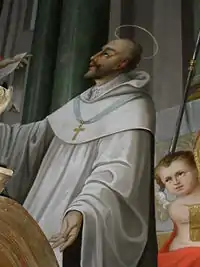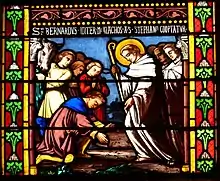Stephen Harding
Stephen Harding (French: Étienne Harding) (c. 1060 – 28 March 1134) was an English-born monk and abbot, who was one of the founders of the Cistercian Order. He is honoured as a saint in the Roman Catholic Church.
St. Stephen Harding, O.Cist. | |
|---|---|
 Saint Stephen Harding fresco in Apátistvánfalva, Hungary | |
| Monk, priest, abbot and co-founder of the Cistercian Order | |
| Born | ca. 1050 Sherborne, Dorset Kingdom of England |
| Died | 28 March 1134 (aged 83–84) Cîteaux Abbey, Duchy of Burgundy |
| Venerated in | Roman Catholic Church (Cistercian Order) |
| Feast | 26 January (Solemnity of the Founders of Citeaux) |
| Attributes | Dressed in the Cistercian cowl, with miniature church model, holding abbot's crozier, holding the Carta Caritatis ("Charter of Charity"), a founding document for the Cistercian Order |
Life
Harding was born in Sherborne, Dorset, in the Kingdom of England, and spoke English, Norman, French, and Latin. He was placed in Sherborne Abbey at a young age and educated at Sherborne,[1] but eventually left the monastery and became a travelling scholar, journeying with one devout companion into Scotland and afterwards to Paris and then to Rome. He eventually moved to Molesme Abbey in Burgundy, which at that time was little more than "a collection of huts".[2] The Abbot was Robert of Molesme (c. 1027–1111). While in Molesme Abbey he seems to have assumed the name Stephen.[3]
When Robert left Molesme to avoid what he perceived to be the abbey's increasing wealth and overly strong connections to the aristocracy, Harding and Alberic of Cîteaux went with him. Seeing no hope of a sufficient reformation in Molesme, in 1098, Robert appointed another abbot for the abbey and then, with Alberic, Harding, and twenty-one other monks, received permission from Hugh, the Archbishop of Lyons and legate of the Holy See, to found a new monastery in Citeaux, a marshy wilderness five leagues from Dijon. There, they formed a new, more austere monastery.[4] Eudes, afterwards Duke of Burgundy, built them a little church which was placed under the patronage of the Blessed Virgin, as all the churches of the Cistercians from that time have been. The Cistercians wore white, in honor of the Virgin Mary, in contrast to the traditional black habit of the Benedictines.

Stephen became the third abbot of Cîteaux. However, very few were joining the community and the monks were suffering from hunger and sickness.[5] In 1112, Bernard of Clairvaux entered the community, bringing with him thirty companions.[6] Between 1112 and 1119, a dozen new Cistercian houses were founded to accommodate those joining the young order. Harding's organisational skills were exceptional; he instituted the system of general chapters and regular visitations. In 1119, he received official approbation for the Carta Caritatis (Charter of Charity), an important document for the Cistercian Order, establishing its unifying principles.[6]
Stephen Harding served Cîteaux Abbey as abbot for twenty-five years. While no single person is considered the founder of the Cistercian Order, the shape of Cistercian thought and its rapid growth in the 12th century were certainly due in some part to Harding's leadership. Insisting on simplicity in all aspects of monastic life, he was largely responsible for the severity of Cistercian architecture and the simple beauty of the Order's liturgy and music.[7] He was an accomplished scribe; his highest achievement is considered to be the famous Harding Bible. In 1133, he resigned as head of the order because of age and infirmity.[6] He died on 28 March 1134,[6] and was buried in the tomb of Alberic, his predecessor, in the cloisters at Cîteaux.[7] Stephen was largely responsible for the severity of Cistercian architecture because he was an adherer of simplicity in all aspects of monastic life.[3]
His feast was celebrated on 28 March until 1683 and then moved to 17 April, where it remained until the liturgical reforms following Vatican II. In a joint commemoration with Robert of Molesme and Alberic, the first two abbots of Cîteaux, the Roman Catholic Church today celebrates Stephen Harding's feast day on 26 January.[8]
References
- "The Sherborne Register 1550-1950" (PDF). Old Shirbirnian Society. Retrieved 8 February 2019.
- Hollingsworth, Gerelyn. "St. Stephen Harding", National Catholic Reporter, March 28, 2011
- "Saint Stephen Harding", Encyclopedia Britannica Retrieved on 31 January 2018
- "St. Stephen Harding". www.ewtn.com. Retrieved 30 May 2017.
- "ST. STEPHEN HARDING :: Catholic News Agency (CNA)". Catholic News Agency. Retrieved 30 May 2017.
- Huddleston, Gilbert. "St. Stephen Harding." The Catholic Encyclopedia Vol. 14. New York: Robert Appleton Company, 1912.
 This article incorporates text from this source, which is in the public domain.
This article incorporates text from this source, which is in the public domain. - "Saint Stephen Harding | St Thomas & St Stephen". www.ss-thomas-stephen.org.uk. Retrieved 30 May 2017.
- "Order of Cistercians of the Strict Observance: OCSO". www.ocso.org. Retrieved 30 May 2017.
![]() This article incorporates text from a publication now in the public domain: Herbermann, Charles, ed. (1913). "St. Stephen Harding". Catholic Encyclopedia. New York: Robert Appleton Company.
This article incorporates text from a publication now in the public domain: Herbermann, Charles, ed. (1913). "St. Stephen Harding". Catholic Encyclopedia. New York: Robert Appleton Company.
Bibliography
| Wikimedia Commons has media related to Saint Stephen Harding. |
- Claudio Stercal, Stephen Harding: A Biographical Sketch and Texts (Trappist, Kentucky: Cistercian Publications, 2008) (Cistercian Studies Series, 226).